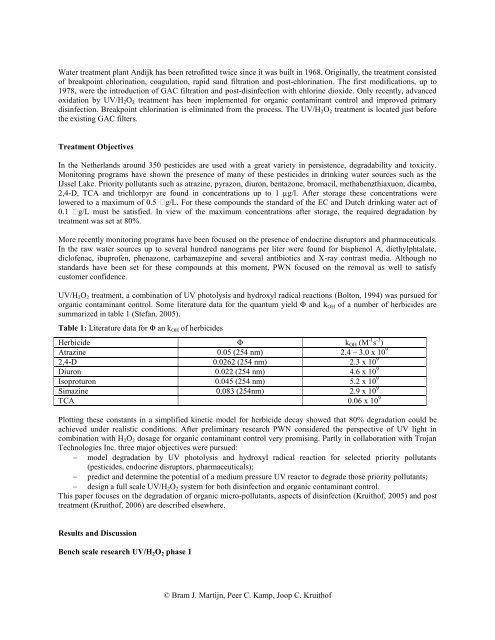UV/H2O2 Treatment an Essential Barrier in a - PWN Technologies
UV/H2O2 Treatment an Essential Barrier in a - PWN Technologies
UV/H2O2 Treatment an Essential Barrier in a - PWN Technologies
Create successful ePaper yourself
Turn your PDF publications into a flip-book with our unique Google optimized e-Paper software.
Water treatment pl<strong>an</strong>t Andijk has been retrofitted twice s<strong>in</strong>ce it was built <strong>in</strong> 1968. Orig<strong>in</strong>ally, the treatment consisted<br />
of breakpo<strong>in</strong>t chlor<strong>in</strong>ation, coagulation, rapid s<strong>an</strong>d filtration <strong>an</strong>d post-chlor<strong>in</strong>ation. The first modifications, up to<br />
1978, were the <strong>in</strong>troduction of GAC filtration <strong>an</strong>d post-dis<strong>in</strong>fection with chlor<strong>in</strong>e dioxide. Only recently, adv<strong>an</strong>ced<br />
oxidation by <strong>UV</strong>/<strong>H2O2</strong> treatment has been implemented for org<strong>an</strong>ic contam<strong>in</strong><strong>an</strong>t control <strong>an</strong>d improved primary<br />
dis<strong>in</strong>fection. Breakpo<strong>in</strong>t chlor<strong>in</strong>ation is elim<strong>in</strong>ated from the process. The <strong>UV</strong>/<strong>H2O2</strong> treatment is located just before<br />
the exist<strong>in</strong>g GAC filters.<br />
<strong>Treatment</strong> Objectives<br />
In the Netherl<strong>an</strong>ds around 350 pesticides are used with a great variety <strong>in</strong> persistence, degradability <strong>an</strong>d toxicity.<br />
Monitor<strong>in</strong>g programs have shown the presence of m<strong>an</strong>y of these pesticides <strong>in</strong> dr<strong>in</strong>k<strong>in</strong>g water sources such as the<br />
IJssel Lake. Priority pollut<strong>an</strong>ts such as atraz<strong>in</strong>e, pyrazon, diuron, bentazone, bromacil, methabenzthiaxuon, dicamba,<br />
2,4-D, TCA <strong>an</strong>d trichlorpyr are found <strong>in</strong> concentrations up to 1 µg/l. After storage these concentrations were<br />
lowered to a maximum of 0.5 �g/L. For these compounds the st<strong>an</strong>dard of the EC <strong>an</strong>d Dutch dr<strong>in</strong>k<strong>in</strong>g water act of<br />
0.1 �g/L must be satisfied. In view of the maximum concentrations after storage, the required degradation by<br />
treatment was set at 80%.<br />
More recently monitor<strong>in</strong>g programs have been focused on the presence of endocr<strong>in</strong>e disruptors <strong>an</strong>d pharmaceuticals.<br />
In the raw water sources up to several hundred n<strong>an</strong>ograms per liter were found for bisphenol A, diethylphtalate,<br />
diclofenac, ibuprofen, phenazone, carbamazep<strong>in</strong>e <strong>an</strong>d several <strong>an</strong>tibiotics <strong>an</strong>d X-ray contrast media. Although no<br />
st<strong>an</strong>dards have been set for these compounds at this moment, <strong>PWN</strong> focused on the removal as well to satisfy<br />
customer confidence.<br />
<strong>UV</strong>/<strong>H2O2</strong> treatment, a comb<strong>in</strong>ation of <strong>UV</strong> photolysis <strong>an</strong>d hydroxyl radical reactions (Bolton, 1994) was pursued for<br />
org<strong>an</strong>ic contam<strong>in</strong><strong>an</strong>t control. Some literature data for the qu<strong>an</strong>tum yield Φ <strong>an</strong>d kOH of a number of herbicides are<br />
summarized <strong>in</strong> table 1 (Stef<strong>an</strong>, 2005).<br />
Table 1: Literature data for Φ <strong>an</strong> kOH of herbicides<br />
Herbicide Φ kOH (M -1 s -1 )<br />
Atraz<strong>in</strong>e 0.05 (254 nm) 2.4 – 3.0 x 10 9<br />
2,4-D 0.0262 (254 nm) 2.3 x 10 9<br />
Diuron 0.022 (254 nm) 4.6 x 10 9<br />
Isoproturon 0.045 (254 nm) 5.2 x 10 9<br />
Simaz<strong>in</strong>e 0.083 (254nm) 2.9 x 10 9<br />
TCA 0.06 x 10 9<br />
Plott<strong>in</strong>g these const<strong>an</strong>ts <strong>in</strong> a simplified k<strong>in</strong>etic model for herbicide decay showed that 80% degradation could be<br />
achieved under realistic conditions. After prelim<strong>in</strong>ary research <strong>PWN</strong> considered the perspective of <strong>UV</strong> light <strong>in</strong><br />
comb<strong>in</strong>ation with <strong>H2O2</strong> dosage for org<strong>an</strong>ic contam<strong>in</strong><strong>an</strong>t control very promis<strong>in</strong>g. Partly <strong>in</strong> collaboration with Troj<strong>an</strong><br />
<strong>Technologies</strong> Inc. three major objectives were pursued:<br />
model degradation by <strong>UV</strong> photolysis <strong>an</strong>d hydroxyl radical reaction for selected priority pollut<strong>an</strong>ts<br />
(pesticides, endocr<strong>in</strong>e disruptors, pharmaceuticals);<br />
predict <strong>an</strong>d determ<strong>in</strong>e the potential of a medium pressure <strong>UV</strong> reactor to degrade those priority pollut<strong>an</strong>ts;<br />
design a full scale <strong>UV</strong>/<strong>H2O2</strong> system for both dis<strong>in</strong>fection <strong>an</strong>d org<strong>an</strong>ic contam<strong>in</strong><strong>an</strong>t control.<br />
This paper focuses on the degradation of org<strong>an</strong>ic micro-pollut<strong>an</strong>ts, aspects of dis<strong>in</strong>fection (Kruithof, 2005) <strong>an</strong>d post<br />
treatment (Kruithof, 2006) are described elsewhere.<br />
Results <strong>an</strong>d Discussion<br />
Bench scale research <strong>UV</strong>/<strong>H2O2</strong> phase 1<br />
© Bram J. Martijn, Peer C. Kamp, Joop C. Kruithof




